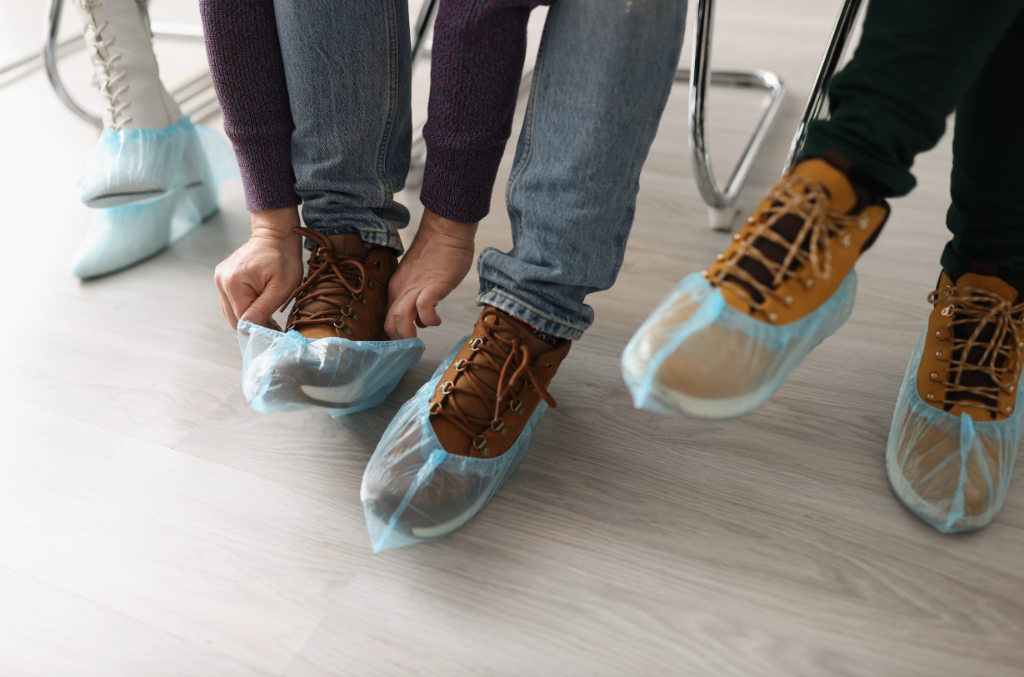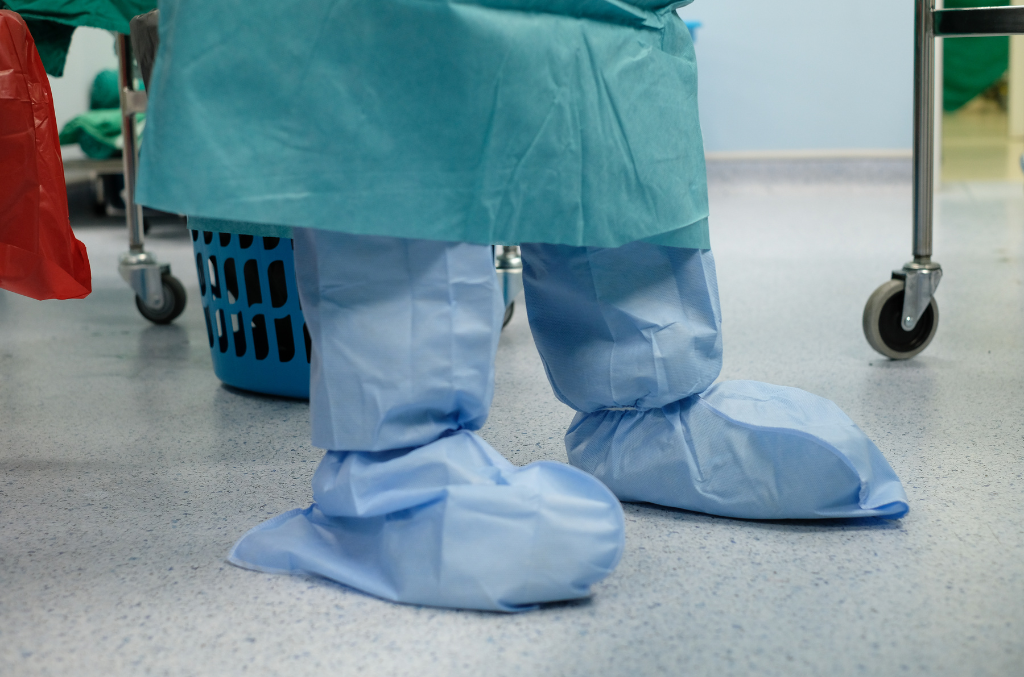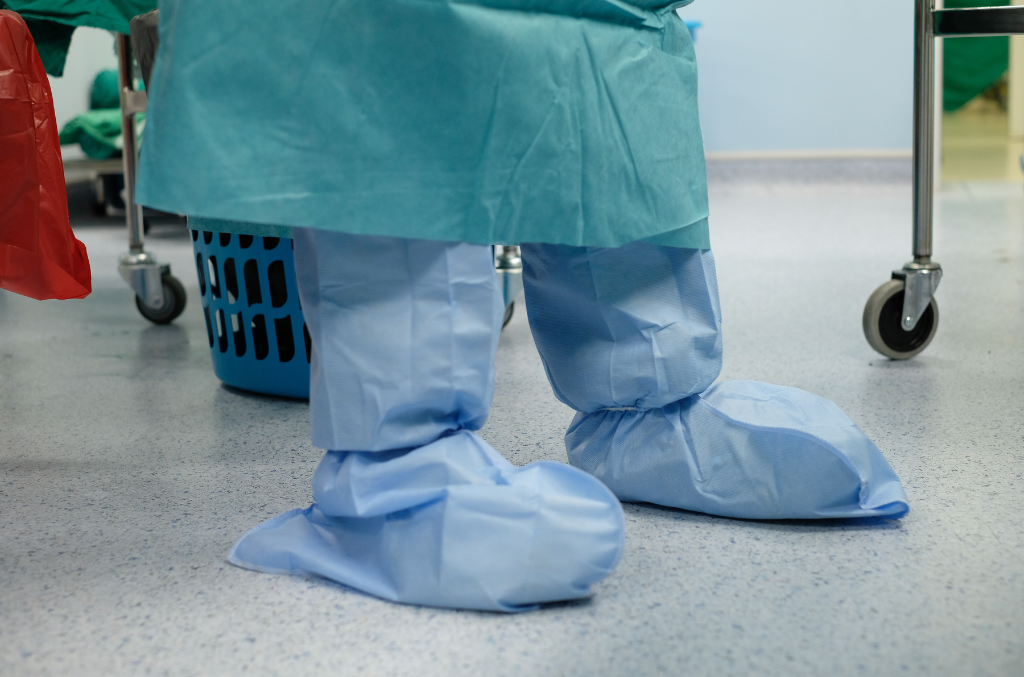Shoe Covers
Importance of Shoe Covers as Part of PPE: A Small Investment, Big Impact
In the world of safety and hygiene, Personal Protective Equipment (PPE) plays a pivotal role in ensuring the well-being of employees across various industries. Among the myriad of PPE available, shoe covers often go unnoticed but are an essential element of maintaining a clean and safe environment. In this article, we delve into the reasons why shoe covers are considered a critical part of PPE.
In This Article
Understanding the Importance of Shoe Covers as Essential PPE

Shoe covers act as a protective barrier, safeguarding both the wearer and the environment from potential hazards. They are designed to prevent the spread of contaminants that can be carried on the soles of shoes, such as dirt, dust, and pathogens. In areas where cleanliness and sterility are paramount, such as in healthcare or manufacturing facilities, the use of shoe covers is not just a safety measure, but a mandatory requirement.
Significance of Shoe Covers in Various Industries
The application of these covers extends beyond just one industry. In healthcare, they are used to prevent the spread of infections and diseases. In manufacturing and distribution, these covers protect employees from potential workplace hazards and help maintain the integrity of the products being manufactured. In educational institutions and building services, they assist in preserving hygiene standards and ensuring a clean environment.
In the subsequent sections, we will explore these aspects in more detail, providing an in-depth understanding of why these covers are an essential piece of PPE.
Understanding Different Types of Reasons Why Shoe Covers are Essential PPE

Shoe covers serve multiple purposes, each contributing significantly to maintaining a safe and sterile environment. Here, we explore the reasons that underline their importance as essential PPE.
Protecting the Workplace Environment from Contaminants
One of the primary purposes of these covers is to prevent the introduction of contaminants into a controlled environment. Shoes can carry a vast range of contaminants including dust, dirt, and biological materials that could compromise the cleanliness and safety of a workspace. By wearing these covers, employees can significantly reduce the risk of contaminating sensitive areas, particularly in industries like healthcare and manufacturing.
Keeping Employees Safe from Workplace Hazards
Shoe covers also provide an additional layer of protection to the wearer. In certain industries, employees may be exposed to hazardous materials or environments where the risk of injury is high. For instance, in the construction or manufacturing sector, these covers made from durable materials can offer protection against sharp objects, harmful chemicals, and even electric hazards.
Preserving Workplace Hygiene Standards
In sectors such as food processing, pharmaceuticals, and healthcare, maintaining high hygiene standards is not just a requirement but a necessity. Shoe covers play a vital role in achieving these standards. They prevent the spread of microorganisms and pathogens that can be brought into these environments on the soles of shoes, thereby helping to maintain a sanitary workspace.
In the following sections, we will delve deeper into the science behind these covers and their industry-specific applications.
The Science Behind Shoe Covers
Understanding the science behind these covers provides valuable insight into their effectiveness as essential PPE. This section breaks down the anatomy and examines how they block contaminants.
Anatomy of Shoe Covers: Material Composition and Design
Shoe covers are often composed of materials such as polypropylene, polyethylene, Tyvek, or vinyl, each lending specific properties to the shoe cover. For instance, polypropylene and polyethylene covers offer excellent protection against liquid splashes, while Tyvek covers are resistant to tears and punctures.
The design also plays a significant role in their effectiveness. Some covers are designed with anti-skid soles to prevent slips and falls, while others may have elastic tops to ensure a secure fit. The right combination of material and design not only enhances the shoe cover’s protective capabilities but also ensures user comfort and ease of use.
How Shoe Covers Block Contaminants: An In-depth Look
Shoe covers work by creating a physical barrier between the shoe and the environment, preventing contaminants present on the shoe from being transferred onto clean surfaces. The materials used in making these covers are largely non-porous, meaning they do not allow particles or fluids to pass through. This makes them effective at blocking a wide range of contaminants, from dust and dirt to harmful microorganisms.
In the next sections, we’ll explore the application of shoe covers in various industries, provide tips for choosing the right cover, and discuss their proper usage and maintenance.
Industry Applications
Shoe covers are widely employed across various industries, each with specific needs and requirements. This section outlines the role of these covers in healthcare, manufacturing and distribution, education, and building services.
Shoe Covers in Healthcare: A Critical Barrier Against Infections

In healthcare settings, the prevention of infections is of utmost importance. These covers play a crucial role in this endeavor, preventing the spread of pathogens carried on the soles of shoes. This is especially important in areas such as operating rooms, isolation wards, and intensive care units, where the risk of infection is high.
Role in Manufacturing & Distribution
In the manufacturing and distribution sectors, these covers help maintain the integrity of the products being manufactured and distributed. They prevent contaminants from entering sensitive areas, thereby reducing the risk of product contamination. Additionally, these covers made from durable materials protect employees from workplace hazards, such as exposure to harmful chemicals or sharp objects.
Importance in Education and Building Services
In educational institutions and building services, maintaining cleanliness is a priority. Shoe covers assist in achieving this by preventing dirt and dust from being tracked into these facilities. This not only helps maintain a clean and hygienic environment but also reduces the need for frequent cleaning.
In the following sections, we’ll provide guidance on choosing the right cover, discuss their proper usage, and delve into the regulatory aspects.
Tips for Choosing Shoe Covers
Choosing the right shoe covers involves considering several factors, including the type of environment in which they’ll be used and the specific hazards they need to protect against. Here are some tips to help you make an informed decision.
Key Features to Look for When Choosing
When selecting, consider the material, durability, and design. If you’re working in a wet environment or with liquids, opt for waterproof materials like polyethylene. For environments with sharp objects or rough surfaces, choose the covers made from tear-resistant materials like Tyvek.
The design of the shoe cover also matters. Anti-skid soles can help prevent slips and falls, while elastic tops ensure a secure fit. Some covers also come with features like reinforced toes for added protection or high tops for extra coverage.
How to Choose the Right Size and Fit
Shoe covers should fit snugly over your shoes without restricting movement. Most covers are designed to fit a range of shoe sizes, but it’s still important to check the manufacturer’s sizing guide before purchasing. Remember, a proper fit not only ensures comfort but also enhances the effectiveness of the shoe cover.
In the following sections, we’ll delve into the proper usage and maintenance of these covers, and discuss the regulatory aspects you need to be aware of.
Proper Usage and Maintenance
Using these covers correctly and maintaining them properly is key to ensuring their effectiveness. This section provides guidelines for properly wearing and their maintenance and disposal.
Steps for Properly Wearing
- Before putting on shoe covers, ensure your hands are clean. This can be achieved by washing with soap and water or using an alcohol-based hand sanitizer.
- Select the right size of shoe cover. It should fit snugly over your shoe without being too tight or too loose.
- Slip your shoe into the shoe cover, starting with the toe and pulling the cover up towards the heel.
- Use your hands to smooth out any wrinkles and ensure the shoe cover is properly fitted over the entire shoe.
Guidelines for Maintenance and Disposal
Shoe covers are typically designed for single use and should be disposed of after removal. They should not be worn outside the designated area to avoid contamination. After use, remove the shoe cover carefully without touching the outer surface, as it may be contaminated. Dispose of used covers in designated waste bins.
In case of reusable covers, follow the manufacturer’s instructions for cleaning and maintenance. Typically, they should be cleaned after each use, either by washing or using an approved disinfectant.
In the next sections, we’ll discuss the regulatory aspects related to these covers and provide a comparison of different brands available in the market.
Regulatory Aspects Of Shoe Covers
Complying with regulatory guidelines is crucial when using these covers as part of your PPE. This section will help you understand the OSHA guidelines and discuss regulatory compliance in different industries.
Understanding the OSHA Guidelines
The Occupational Safety and Health Administration (OSHA) provides guidelines for the use of Personal Protective Equipment (PPE), including such covers. According to OSHA, employers must provide PPE to their employees and ensure its proper use in workplaces where hazards are present. Although OSHA does not specify the use of shoe covers, they may be required under the general duty clause if they are necessary to keep the work environment safe and clean.
Regulatory Compliance in Different Industries
In industries such as healthcare and food processing, additional regulations may apply. For instance, the Food and Drug Administration (FDA) mandates the use of PPE, in areas where food is processed to prevent contamination. Similarly, in healthcare settings, the Centers for Disease Control and Prevention (CDC) recommends the use of these covers when dealing with infectious materials.
In the next sections, we’ll compare different brands and highlight the quality and reliability.
Different Brands
Choosing the right brand of shoe cover can have a significant impact on their effectiveness and reliability.
Brands in the Market
Several brands offer high-quality shoe covers, each with their unique features. Such as, resistance to tears and punctures, anti-skid properties for safer use in slippery environments and fluid-resistant properties, for wet environments.
In the final section, we’ll reiterate the importance of these covers as essential PPE and emphasize their role in ensuring safety and hygiene.
Summary Of Discussion
In the realm of Personal Protective Equipment (PPE), shoe covers hold a significant but often overlooked position. Their role extends beyond just covering shoes; they act as a critical barrier against contaminants, ensuring the safety of both the wearer and the environment.
Reiterating the Importance of Shoe Covers as Essential PPE
The importance of these covers as essential PPE cannot be overstated. They protect the workplace environment from contaminants, keep employees safe from workplace hazards, and help preserve workplace hygiene standards. Whether it’s a healthcare facility, a manufacturing plant, or an educational institution, the use of these covers contributes significantly to maintaining a clean and safe environment.
Emphasizing the Role of Shoe Covers in Ensuring Safety and Hygiene
The role of these covers in ensuring safety and hygiene is paramount. By creating a barrier between shoes and the environment, they prevent the spread of dirt, dust, and harmful pathogens. Additionally, in hazardous environments, they provide an added layer of protection to the wearer.
When choosing shoe cover, it’s important to consider the material, design, and size. With proper usage and maintenance, shoe cover can significantly enhance the safety and cleanliness of your workspace.
Frequently Asked Questions (FAQ)
At IP Products, we offer a wide range of Shoe Covers to meet your needs. Browse our collection today and find the perfect Shoe Covers for your job. We are dedicated to quality, customer satisfaction, and fast shipping.

